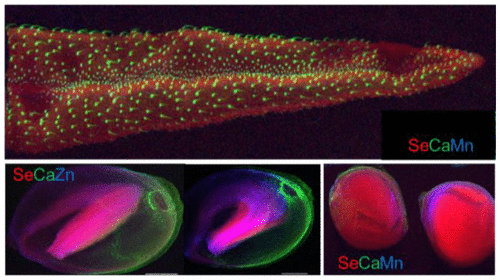当前位置:
X-MOL 学术
›
Environ. Sci. Technol.
›
论文详情
Our official English website, www.x-mol.net, welcomes your
feedback! (Note: you will need to create a separate account there.)
Selenium Metabolism in Hemp (Cannabis sativa L.)-Potential for Phytoremediation and Biofortification.
Environmental Science & Technology ( IF 10.8 ) Pub Date : 2020-03-27 , DOI: 10.1021/acs.est.9b07747 Gavin C Stonehouse 1 , Brandon Jude McCarron 1 , Zack S Guignardi 1 , Ali F El Mehdawi 1 , Leonardo W Lima 1 , Sirine C Fakra 2 , Elizabeth A H Pilon-Smits 1
Environmental Science & Technology ( IF 10.8 ) Pub Date : 2020-03-27 , DOI: 10.1021/acs.est.9b07747 Gavin C Stonehouse 1 , Brandon Jude McCarron 1 , Zack S Guignardi 1 , Ali F El Mehdawi 1 , Leonardo W Lima 1 , Sirine C Fakra 2 , Elizabeth A H Pilon-Smits 1
Affiliation

|
Selenium (Se) deficiency and toxicity affect over a billion people worldwide. Plants can mitigate both problems, via Se biofortification and phytoremediation. Here we explore the potential of hemp (Cannabis sativa L.) for these phytotechnologies. Field surveys in naturally seleniferous agricultural areas in Colorado, United States, found 15–25 μg of Se/g in seed and 5–10 μg of Se/g dry weight (DW) in flowers and leaves. Thus, 4 g of this hemp seed provides the U.S. recommended daily allowance of 55–75 μg of Se. In controlled greenhouse experiments, hemp seedlings grown in Turface supplied with 40–320 μM selenate showed complete tolerance up to 160 μM and accumulated up to 1300 mg of Se/kg shoot dry weight. Mature hemp grown in Turface supplied with 5–80 μM selenate was completely tolerant up to 40 μM selenate and accumulated up to 200 mg of Se/kg DW in leaves, flowers, and seeds. Synchrotron X-ray fluorescence and X-ray absorption spectroscopies of selenate-supplied hemp showed Se to accumulate mainly in the leaf vasculature and in the seed embryos, with predominant Se speciation in C–Se–C forms (57–75% in leaf and more than 86% in seeds). Aqueous seed extracts were found by liquid chromatography mass spectrometry to contain selenomethionine and methyl-selenocysteine (1:1–3 ratio), both excellent dietary Se sources. Floral concentrations of medicinal cannabidiol (CBD) and terpenoids were not affected by Se. We conclude that hemp has good potential for Se phytoremediation while producing Se-biofortified dietary products.
中文翻译:

大麻中的硒代谢(大麻)-植物修复和生物强化的潜力。
硒(Se)缺乏和毒性影响全球超过十亿人。植物可以通过硒的生物强化和植物修复来缓解这两个问题。在这里,我们探索大麻的潜力(大麻L.)这些植物技术。在美国科罗拉多州的天然硒化农业地区进行的实地调查发现,种子中的Se / g为15–25μg,花朵和叶子中的Se / g干重(DW)为5–10μg。因此,4克这种大麻籽可提供美国建议的55-75微克硒的每日允许量。在受控的温室实验中,在Turface中生长的大麻幼苗提供40-320μM的硒酸盐,显示出完全的耐受性,高达160μM,累积的硒含量为1300 mg / kg枝干重。在Turface中生长的成熟大麻中提供5–80μM硒酸盐是完全耐受的,高达40μM硒酸盐并在叶,花和种子中积累了高达200 mg Se / kg DW。硒酸盐提供的大麻的同步辐射X射线荧光光谱和X射线吸收光谱表明,硒主要在叶脉管系统和种子胚中积累,硒形态以C–Se–C形式占优势(叶子中57-75%,种子中86%以上)。通过液相色谱质谱法发现种子水提取物含有硒代蛋氨酸和甲基硒代半胱氨酸(1:1–3的比例),两者都是良好的膳食硒来源。药用大麻素(CBD)和萜类化合物的花香浓度不受硒的影响。我们得出的结论是,大麻在生产硒生物强化饮食产品的同时具有很好的硒植物修复潜力。
更新日期:2020-03-27
中文翻译:

大麻中的硒代谢(大麻)-植物修复和生物强化的潜力。
硒(Se)缺乏和毒性影响全球超过十亿人。植物可以通过硒的生物强化和植物修复来缓解这两个问题。在这里,我们探索大麻的潜力(大麻L.)这些植物技术。在美国科罗拉多州的天然硒化农业地区进行的实地调查发现,种子中的Se / g为15–25μg,花朵和叶子中的Se / g干重(DW)为5–10μg。因此,4克这种大麻籽可提供美国建议的55-75微克硒的每日允许量。在受控的温室实验中,在Turface中生长的大麻幼苗提供40-320μM的硒酸盐,显示出完全的耐受性,高达160μM,累积的硒含量为1300 mg / kg枝干重。在Turface中生长的成熟大麻中提供5–80μM硒酸盐是完全耐受的,高达40μM硒酸盐并在叶,花和种子中积累了高达200 mg Se / kg DW。硒酸盐提供的大麻的同步辐射X射线荧光光谱和X射线吸收光谱表明,硒主要在叶脉管系统和种子胚中积累,硒形态以C–Se–C形式占优势(叶子中57-75%,种子中86%以上)。通过液相色谱质谱法发现种子水提取物含有硒代蛋氨酸和甲基硒代半胱氨酸(1:1–3的比例),两者都是良好的膳食硒来源。药用大麻素(CBD)和萜类化合物的花香浓度不受硒的影响。我们得出的结论是,大麻在生产硒生物强化饮食产品的同时具有很好的硒植物修复潜力。











































 京公网安备 11010802027423号
京公网安备 11010802027423号